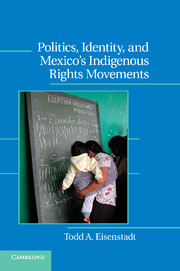Book contents
- Frontmatter
- Contents
- List of Tables and Figures
- Preface and Acknowledgments
- 1 SURVEYING THE SILENCE
- 2 A TALE OF TWO MOVEMENTS
- 3 INDIVIDUAL AND COMMUNITARIAN IDENTITIES IN INDIGENOUS SOUTHERN MEXICO
- 4 AGRARIAN CONFLICT, ARMED REBELLION, AND THE STRUGGLE FOR RIGHTS IN CHIAPAS' LACANDON JUNGLE
- 5 CUSTOMARY PRACTICES, WOMEN'S RIGHTS, AND MULTICULTURAL ELECTIONS IN OAXACA
- 6 FROM BALACLAVAS TO BASEBALL CAPS
- 7 RECONCILING INDIVIDUAL RIGHTS, COMMUNAL RIGHTS, AND AUTONOMY INSTITUTIONS
- Bibliography
- Index
- Titles in the series
1 - SURVEYING THE SILENCE
TRADITIONAL SOCIETIES, INDIGENOUS RIGHTS, AND THE STATE IN SOUTHERN MEXICO
Published online by Cambridge University Press: 04 April 2011
- Frontmatter
- Contents
- List of Tables and Figures
- Preface and Acknowledgments
- 1 SURVEYING THE SILENCE
- 2 A TALE OF TWO MOVEMENTS
- 3 INDIVIDUAL AND COMMUNITARIAN IDENTITIES IN INDIGENOUS SOUTHERN MEXICO
- 4 AGRARIAN CONFLICT, ARMED REBELLION, AND THE STRUGGLE FOR RIGHTS IN CHIAPAS' LACANDON JUNGLE
- 5 CUSTOMARY PRACTICES, WOMEN'S RIGHTS, AND MULTICULTURAL ELECTIONS IN OAXACA
- 6 FROM BALACLAVAS TO BASEBALL CAPS
- 7 RECONCILING INDIVIDUAL RIGHTS, COMMUNAL RIGHTS, AND AUTONOMY INSTITUTIONS
- Bibliography
- Index
- Titles in the series
Summary
For nearly two decades, leaders of the Zapatista social movement in Chiapas, Mexico, have claimed to speak on behalf of the region's disenfranchised rural dwellers. The Zapatistas, led by the ubiquitous and awe-inspiring Subcommander Marcos, have claimed to give voice to the voiceless. On January 1, 1994, the Zapatista Army of National Liberation declared war on the Mexican state, demanding radical class warfare (immediately) and pan-indigenous self-government and autonomy (eventually). This uprising was immediately met with violent suppression by Mexican authorities, but the Zapatistas have continued to be a force for political, economic, and social change in Chiapas.
Much has been written about the organization's violent beginning. Comparatively little has been written about the indigenous jungle dwellers in whose name the Zapatistas took up arms. This book gives these rural Chiapas residents voice, finally, through a comprehensive survey and case study. Among the questions addressed are: How many followers do the Zapatista leaders actually represent? How many of Chiapas' poor, dispossessed peasants actively participated in the Zapatista cause in the late 1990s? How many shared the movement's objectives but did not participate? How many opposed the armed rebellion in 1994? How many have lost faith in the succeeding years?
- Type
- Chapter
- Information
- Publisher: Cambridge University PressPrint publication year: 2011

